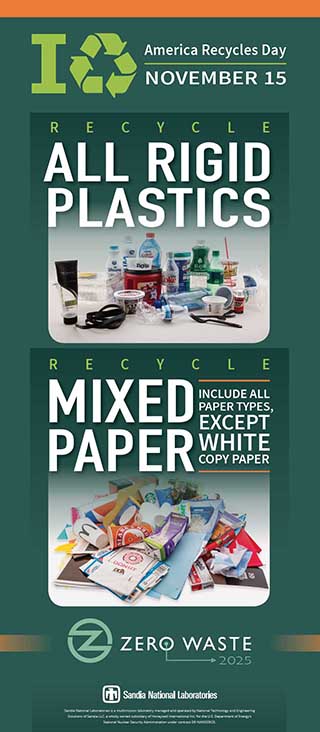Sandia responds to changes in recycling market

See also: Keep Sandia’s recyclables supply chain clean
Nov. 15 is America Recycles Day, and the news this year is that Sandia is focused on smart recycling.
Everyone knows the drill: Each year, Sandians, like other Americans, are asked to recycle more, and we have. But international market changes underway may impact how and where those recyclables are processed.
China drives recycling market changes
For many years, China has been the largest importer of US recyclables and has become the world’s largest processor of recyclables. But that industry has come with a cost. Over time, China claims, the quality of recyclables being imported into China has gone down, resulting in sorting, cleaning, and disposal expenses for waste within the recyclables supply chain. This drives down margins in an already thin-margined industry, and raises Chinese disposal costs.
Add to that the rise of China’s middle class and consumer culture, and it’s led to China making industry changes that have large implications for American organizations and municipalities that generate recycling for export.
“There are other markets, but China is the big one,” says Sam McCord from Sandia’s Materials Sustainability & Pollution Prevention (MSP2) program. “Changes made by China are driving changes in the entire industry and in recycling practices.”
Since 2013, China’s Operation Green Fence has sought to improve the quality of recyclables being brought into China for processing. More recently, China’s Operation National Sword has tightened importing rules intended to help Chinese processors avoid some of the waste problems that come from recyclables contaminated with pollutants like food and trash, and their own increasing recycling amounts. The standards are tightening, and the results will be felt by Americans.
“In the US, some municipalities are concerned their recyclables won’t be accepted by China any more, and those municipalities have to find other processing partners or make the difficult decision to landfill the materials they can’t offload,” says Sam.
Sandia and many other large members of the New Mexico Recycling Coalition are taking action to increase participation and decrease contamination, Sam says.
How/what Sandia recycles
MSP2 team member Ralph Wrons says about 120,000 to 130,000 pounds of white paper annually is shipped in locked semi-trailers to a domestic paper recycling mill, where a Sandian witnesses the paper being unloaded onto a conveyor and into a pulping vat.
“The end product actually becomes materials for the copy paper production process, and Sandia buys its copy paper from one of the paper mills that processes Sandia’s recycled white paper,” Ralph says.
The process for plastics and mixed paper is a little different.
Sam says Sandia annually sends more than 60,000 pounds of rigid plastics and more than 150,000 pounds of mixed paper to a local processor/broker that also processes the city of Albuquerque’s recyclables.
Each time a load of plastic or mixed paper is ready, the broker puts it out for bid on the secondary materials market, and will sell it to the highest bidder. That highest bidder may or may not be domestic.
Keep Sandia recyclables clean
To ensure that Sandia’s recyclables are acceptable for processing, Sandia’s MSP2 program is asking Sandians to ensure that Sandia recyclables are clean and free of contamination that could limit its usefulness for processing.
“Ensure that only rigid plastics are put in plastics recycling bins, and that the plastics are free of food and other waste,” Sam says.
Sam says plastic films can damage equipment used in the recycling processing process. Sandia facilities that use lots of plastic films recycle them separately, and Sandia recycles about 2,500 pounds of films, but that larger-scale film recycling isn’t practical at this time.
“Recycle white paper only in the bins that are intended for just white paper, and ensure that mixed paper bins are clean and free of waste such as food and trash,” says Sam.
Keep Sandia’s recyclables supply chain clean
Here are some ways to keep Sandia’s recyclables clean and contamination-free:
- Only recycle clean, rigid plastics in the plastics recycle bins
- Keep mixed paper bins free of trash and other non-paper recyclables
- Recycle white paper only in white paper bins
New “Zero Waste by 2025” signs on recycling bins will include recycling guidance.